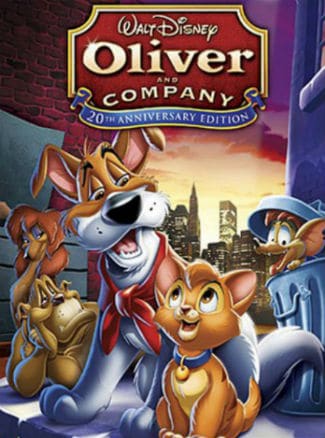
Welcome to Revisiting Disney! Today, we’re looking at that movie which asked the very valid question, why should we worry? This is Oliver & Company! Like always, I have labeled each category so if you want to skip to the parts that interest you most, feel free. And, of course, if you have any thoughts, burning or otherwise, please share in the comments!
BACKGROUND OF OLIVER & COMPANY
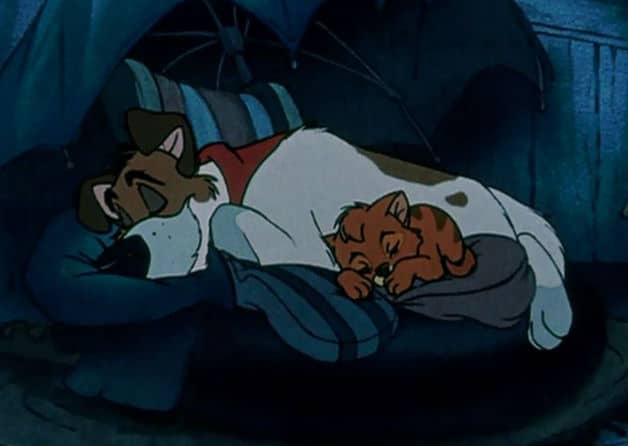
Photo: Disney
Released on November 18th, 1988, Oliver & Company is one of those films that, looking at it, really shouldn’t work. It’s Charles Dickens’ Oliver Twist, in 1980’s New York City, with a cat and pickpocket dogs. It sounds as crazy as making an animated film version of “Hamlet,” and casting lions as the main characters. Don’t worry; we’ll get to that one. Regardless, there is something about this movie that I still love today. Maybe it’s the music or the animation style?
Either way, Oliver & Company has been considered by some, including animation historian Bob Thomas, to be a confirmation that the Disney studio could survive after the disappointment of The Black Cauldron. Oliver, together with The Great Mouse Detective and Who Framed Roger Rabbit? (the film that Ollie Johnston and Frank Thomas give credit to for kick-starting the Disney Renaissance) gave the studio a much-needed boost. This allowed them to make a little film that you may have heard of, The Little Mermaid.

Photo: Disney
Thomas also called Oliver & Company “the first out-and-out comedy amongst the Disney features,” and “proof that Disney animation could appeal to the teenage crowd,” (Thomas 1992: 117). It was a success. The songs were written by talented men, and performed by pop stars of the day (we’ll get to that too).
MUSIC
Music-wise, a lot of talented people were involved in the music of this film. Oliver & Company was nominated for the “Best Original Song Motion Picture Golden Globe in 1989 for the song “Why Should I Worry?” This song was written by Dan Hartman and Charlie Midnight, and performed by the voice of Dodger, Billy Joel.
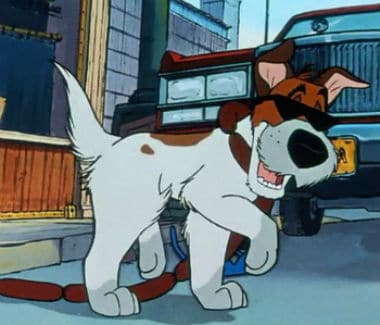
Photo: Disney
The opening number, “Once Upon a Time in New York City,” comes from Barry Mann (music) and Howard Ashman (lyrics). “Streets of Gold,” by Dean Pitchford and Tom Snow, was performed by R&B singer Ruth Pointer of The Pointer Sisters. “Good Company” was written by Rob Minkoff (lyrics) and Ron Rocha (music), and performed by Myhanh Tran.
The final number that everyone recognizes, “Perfect Isn’t Easy,” was written by Barry Manilow, Jack Feldman, and Bruce Sussman, and performed by Bette Midler. The talents of the songwriters, plus the added star power of Billy Joel, Ruth Pointer, and Bette Midler, make Oliver & Company a movie with a soundtrack that is hard to forget.

Photo: Disney
The score was composed by J.A.C. Redford, who in addition to his long list of compositions, worked on the music for James Cameron’s Avatar as the orchestrator. The soundtrack is fun, upbeat and fits into the music of the day. Like older films, it takes bits from the songs in the film and weaves them together in a fun way.
It’s clear that the film was trying to appeal to a broader audience, and the music was an effective tool to do that. As a kid, I didn’t get that the dogs were pickpockets, but I knew that “Why Should I Worry?” was one of my favorite songs to dance to.
ANIMATION
Animation-wise, Oliver & Company is unique in that it is the first Disney animated film to have an entire department devoted to creating computer generated animation. Most of the objects that the characters interact with were created on the computer, making this one of the first films to use this much computer animation. With The Great Mouse Detective and The Black Cauldron having paved the way, Oliver & Company took advantage of the hard-earned tech and developed it even further.
This was also the last of the Disney films to use line overlay or cell overlay. This technique was used to help the backgrounds and the Xeroxed characters and things within the film blend in better. There were six supervising animators, and the team was made up of over 200 people. The Special Edition “Fact Reel” tells me that this film “was considered a landmark achievement of its time, as it blended traditional cell animation with computer-generated imagery.”

Photo: Disney
Stylistically, the film reminds me a lot of 101 Dalmatians, in that it has a very contemporary background and very realistic characters that contrast with each other while still matching and fitting together. It’s not a clash per se; you just wouldn’t think it could work as well as it does.
It’s also very interesting to me that the background of Oliver & Company was based on actual photos taken of New York, with the cameras set at the level of a dog or cat, to make the viewer feel like they were there. The fact that the studio was that concerned with accuracy and the experience of the audience, especially when it comes to things that I always take for granted when watching a film, reminds me of the artistic talent that goes into filmmaking. Like with Lady and the Tramp and 101 Dalmatians, dogs were brought into the studio for live-action references.
THE PLOT
When it comes to the writers and the new Disney team, we’re going to spend some time next week talking about some new Disney staff and also a couple of the Nine Old Men (who just suddenly left, so I missed them in the earlier films). I’ll just say that Kirk Wise, Gary Trousdale, Chris Bailey, Chris Buck, Andreas Deja, Glen Keane, and a host of other talented people will come up again before we finish this journey.
We open up with a box of kittens, playing and trying to be as cute as possible so they get adopted. One of them, little Oliver, is not adopted and is instead left in a cardboard box, outside, in the rain, overnight. After almost getting washed down a storm drain and chased by stray dogs, he takes shelter on the tire of an old truck (always check your tires before driving, just in case).
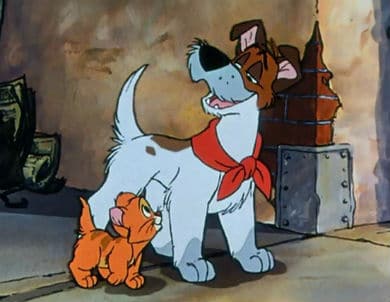
Photo: Disney
While trying to find food and a family the next day, he runs into a smooth-talking dog, Dodger, who promises to teach him how to survive on the street. Dodger, being a street-wise dog, had actually just wanted to use Oliver to cause a distraction while he stole a string of hot dogs from a local vendor.
This theft and Oliver’s indignant reaction to what he sees as a betrayal lead into the song, “Why Should I Worry?” performed to perfection by Billy Joel. The number spirals to include every dog in downtown New York, with Dodger explaining his life philosophy on not worrying.
Thinking he’s lost the gullible little cat, Dodger heads home to his friends, not realizing that Oliver is following him home. Here, we meet the gang, or the “Company” in Oliver & Company. These characters include Francis (a bulldog with delusions of grandeur), Einstein (an older but a little slower dog), Rita (the street-smart, down-to-earth and tough lady of the gang), and Tito (a hyperactive chihuahua with a passion for salsa and voiced by Cheech Marin).
When Dodger shows up with the hotdogs, he spins a tale of his dangerous quest to get food for his friends. Unfortunately for him, Oliver falls in through the roof and once they realize what happened, the gang proceeds to tease Dodger mercilessly for needing to get help from a cat.
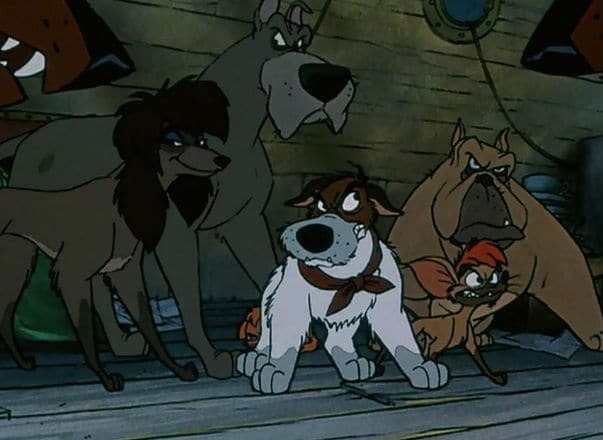
Photo: Disney
When the dogs’ owner Fagin arrives home, we learn that he apparently owes a lot of money to a loan shark named Sykes, who has two Doberman Pinchers that serve as his gang. Sending the dogs down to keep Fagin’s pack of pickpockets under control, Roscoe, the lead, proceeds to try to put the moves on Rita while Desoto (the other one), tries to eat Oliver. When Oliver scratches Desoto in self-defense, only the stepping in of the gang and Sykes calling his dogs back prevents an all-out brawl.
It turns out that Sykes has given Fagin three days to pay off his massive loan, or Sykes will have him killed. Sykes is a terrifying villain to me in that he is the kind that could actually exist; a wealthy criminal who will stop at nothing to get what he wants, even kidnapping a little girl.
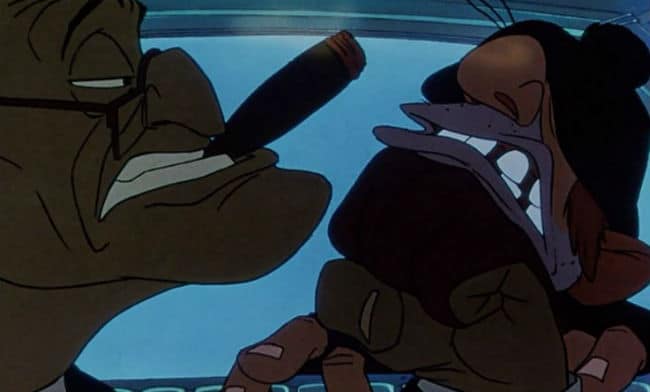
Photo: Disney
It’s a weird situation, though, because we want to root for Fagin, the petty criminal, to beat out Sykes, the mob boss and loan shark. One’s a bad guy, but not too bad, and the other is a straight-up bad guy. Morally, who do you root for in this movie?
The next morning, the team sets out to try to pickpocket enough to save their owner. Fagin inspires them with the wonderful line, “Dead men do not buy dog food,” and as Oliver heads out with the gang, they start to teach him how to survive on the streets.
Seeing a limo, the dogs set up a distraction. Rita and Dodger will pickpocket the crowd who assembles when Einstein runs into the limo, Francis will pretend to be hit and draw a crowd while Tito messes with the electronics inside the limo.
Tito and Oliver didn’t realize that Jenny, a little girl, was in the back of the limo and when Oliver sees the shadow in the back he accidentally turns the key. This electrocutes Tito and he is flung from the car while Oliver is trapped inside
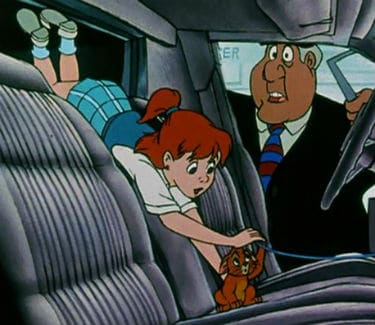
Photo: Disney
Luckily for Oliver, Jenny, the little girl, sees Oliver and untangles him. She falls in love instantly, and, despite her caregiver Winston’s objections, she is sure her parents won’t mind her keeping the little cat.
Oliver is not the only pet in Jenny’s 5th Avenue townhouse, however. She also has a pureblood poodle, Georgette, who is less than amused at the idea of having to share her house with another pet, particularly a small cat. Jenny is sure that her four-legged friends, both so beloved by her, are going to be great friends. I have my doubts at this point.
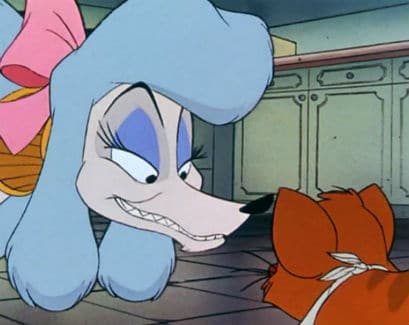
Photo: Disney
While Dodger and the gang try to help Fagin find the money to pay off Sykes, they are also convinced that Oliver was captured and is being punished for being part of their schemes. He’s also part of their family, so they are trying to figure out a way to bust him out.
During this, however, Jenny and Oliver are bonding and going on adventures and it turns out that all pets really want, as much as they love each other is to have a human companion to love and care for them.
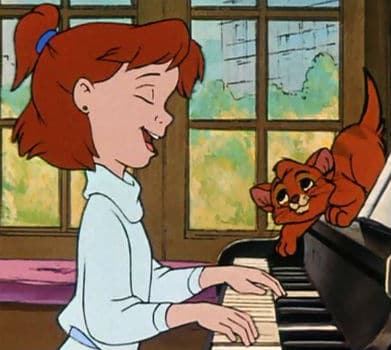
Photo: Disney
Oliver seems to be having a wonderful time and really loves his new owner (even if he doesn’t seem to know how to feel about Georgette). Georgette is clearly jealous of this new figure who monopolizes the time of her person, and when Dodger comes to get Oliver she jumps at the chance to get rid of him.
As the Gang is exploring the house and trying to find Oliver, however, Rita points out several times that it seems like the kind of house where Oliver could be happy and that, maybe, even though they’ll miss him, he might be better off there. Dodger doesn’t listen, however, and with Georgette’s help, they liberate their friend.
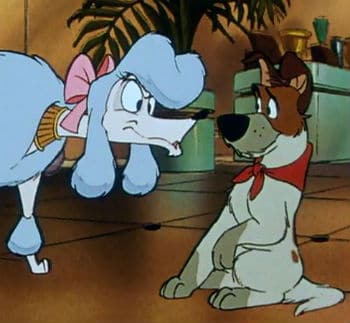
Photo: Disney
Jenny is distraught, and, far away at the barge where the gang lives, Oliver is also pretty upset. He loves his friends but misses his person. Dodger is hurt, though he tries to play it cool, poking fun at Oliver for being too upper-class to talk to his old friends. Oliver tries to explain, but can’t, and he clearly wishes that he could explain to his friends.
As he is getting ready to leave, Fagin comes in and, seeing the address on Oliver’s collar, decides to hold him for ransom. Jenny finds the note and sets off immediately, piggy bank in hand and Georgette in leash, to save her cat.
Meanwhile, Fagin goes to see Sykes and tell him about his new plan, using Oliver to get ransom money to pay Sykes back. Fagin isn’t good at talking to Sykes, he’s clearly scared of him, and it takes Sykes setting his dogs on him (and Dodger fighting them to defend his master) for Fagin to spit out his plan.

Photo: Disney
Sykes is impressed, and things seem to be looking up. However, when Jenny turns up with a piggy bank in a terrible part of town, scared and alone, Fagin pretends to find Oliver and reunites the two. Unfortunately, Sykes is watching and kidnaps Jenny, canceling his account with Fagin.
Oliver is scared for his person, but Dodger promises that they’ll save her. With Georgette, they set off to rescue Jenny from Sykes. He is, meanwhile, preparing to ransom her back to her parents (who are at a conference in Rome, so fairly well-off).
Using the street smarts that they have honed over the years through their theft, the gang’s first task is to throw Oliver into the building in a homemade catapult. This works, and he lets the rest of the gang in. They figure out where Jenny is, and develop a plan to get her out.
Using the street smarts that they have honed over the years of theft, the gang figures out where Jenny is, and develop a plan to get her out. First of all, they put Oliver in an old helmet and toss him into the building through a window. The Dobermans are sent to investigate, and Oliver sneaks around them, letting the others in through a window.
On locating Jenny, the plan develops further. With Roscoe and Desoto having caught their scent, a diversion is needed. Francis, Tito, and Einstein impersonate a pizza delivery guy, drawing Sykes out of the room where Jenny is held. This allows Oliver and Dodger to bust in and work on saving her.
Georgette and the decoys manage to trap the Dobermans under a canvas, and the whole gang rushes in. Rita goes to work on chewing through Jenny’s bonds while Francis is supposed to be watching the monitor. He gets distracted by the color TV, and the team finds themselves trapped in the room.
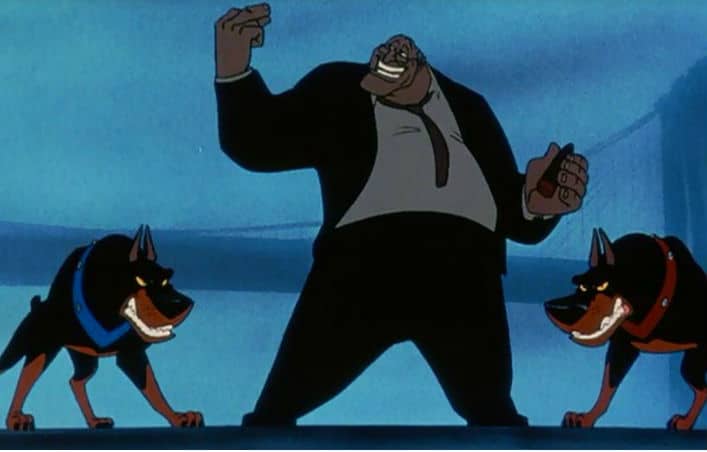
Photo: Disney
Tito manages to hotwire a crane and, with everyone piled on Jenny’s chair, lifts them through the air and to freedom, just as Sykes and his dogs burst into the room. Sykes, not to be outdone, grabs an ax, causes the chair to drop and the whole gang to slide down an old conveyor belt, where they encounter Sykes and his dogs.
Just when things look hopeless, Fagin bursts in through another window and scoops up Jenny, Oliver, and every dog. They think they can escape, but Sykes gives chase in his car. Even trying to escape into the subway doesn’t deter him, as he just drives his car onto the track.
In the confusion of a car chasing a scooter/cart through the subway tunnels, Sykes is able to ram into the back of the scooter, causing Jenny to fall off and land on the hood of his car. Sykes grabs her, but Oliver will not let his human be hurt. He jumps onto the car and bites Sykes’ hand. Sykes lets go of Jenny, but he flings Oliver into the backseat of his car. This leaves Oliver alone with two angry and hungry Dobermans.
Seeing Oliver in trouble, Dodger jumps into the car as well. Roscoe and Dodger are thrown out the back window in the scuffle. Trying to take Dodger down with him, Roscoe falls off into the tunnel and is electrocuted (the car with no wheels and the subway make a dangerous combination).
Enraged, Desoto takes revenge. Although he almost succeeds in pushing Dodger off of the back of the car into the tunnel, Oliver jumps in. This pushes Desoto off the car, and the Dobermans are no more. Oliver, in the flurry, almost falls off the car himself, but Dodger catches him.
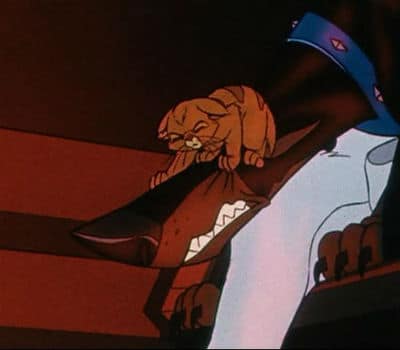
Photo: Disney
Meanwhile, Jenny is still riding on the hood of Sykes’ car. Calling for help, Fagin jumps to the back and, when Oliver and Dodger attack Sykes, she is able to jump to Fagin. Fagin’s absence from the wheel gives Tito control of the scooter, and, with Georgette behind him (freaking out a little bit) and a subway coming towards him, he is able to maneuver the scooter out of harm’s way.
Sykes is not so lucky, and since he is distracted by Dodger and Oliver, the subway hits him head on. He dies in a fiery explosion. When the gang comes back down to the sub line, Jenny is very concerned for Oliver. When Dodger appears, holding a limp little figure in his mouth, we think the worst.
Luckily, this is an old-school Disney movie, so the main characters are pretty safe. Oliver’s just knocked out. He wakes up and everyone is really happy to see him. He also succeeds in uniting his two families, as the end of the movie is everyone together at Jenny’s birthday party.
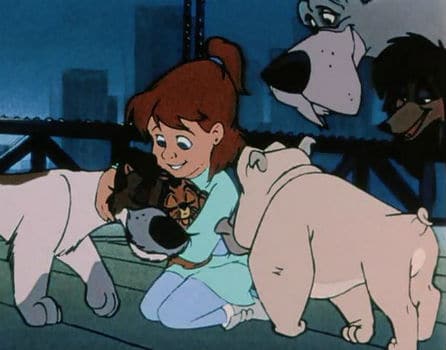
Photo: Disney
Georgette, having finally come around to Oliver and Tito, decides that Tito isn’t too bad after all (he’s been flirting with her throughout the film), but when he learns that she wants him to change, he changes his mind and realizes that he likes his life, as is.
Dodger and Oliver say goodbye, but promise that it’s not forever (the gang does mean family, after all) and make Oliver the Vice President, who happens to live uptown. The other dogs head home, singing a reprise of “Why Should I Worry?” Oliver and Jenny stay at 5th Street, and we assume that they all live happily ever after.
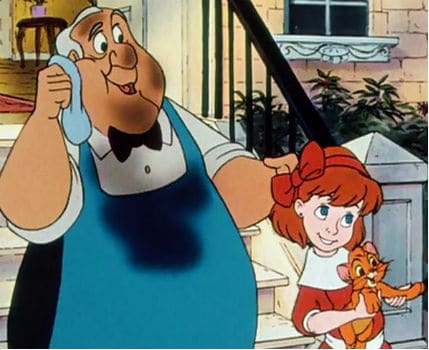
Photo: Disney
SOURCE MATERIAL
Originally, the film was going to be a sequel to the very popular film, The Rescuers, however, that idea was changed for a modern retelling of the story of Oliver Twist, but with animals in the ’80s.
I feel like this is the place to admit that I have never actually read Oliver Twist. It’s like Moby Dick in that I’m very familiar with the story and the characters. I’ve even read the abridged version and love other things by the author, but, despite hearing great things about it, it is part of the huge pile of books that I am sure will someday crush me in my sleep.
Regardless, Oliver Twist was written by Charles Dickens, with the third edition coming out in 1841. According to the preface in my copy, this was Dickens’ second novel, coming hot on the heels of his highly successful and very funny The Pickwick Papers, Oliver Twist is something different.
In the novel, Dickens and his readers follow the story of poor orphaned Oliver Twist in his truly awful childhood. We all are probably familiar with the “Please Sir, I’d like some more” line, and this is where it comes from. It shows the seedy, dark, and often really violent side of Victorian life while giving us wonderful characters.
These characters include Artful Dodger, who takes little Oliver under his wing and introduces him to the gang, Fagin, the gang leader, and, of course, Oliver himself. It’s been said that Oliver was written to show that good can triumph over even the most horrible circumstance, and the story also served to raise public awareness (like The Jungle by Upton Sinclair would in America).
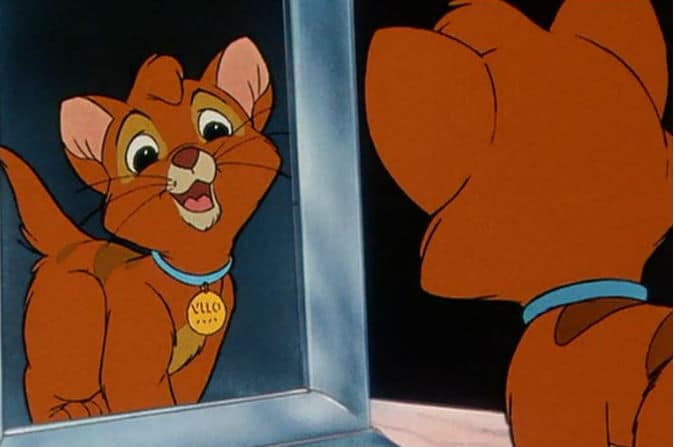
Photo: Disney
Since Dickens is a master of the written word, he paints a picture (at least in the first five or so pages) or what life was like for these characters; Oliver Twist is a character who most of us know, and often finds his way into film (the film August Rush borrows a lot from Oliver Twist as well).
The 1980’s
The ’80’s, I have to admit, are dragging a little bit here. I know a lot happened, but man. There were a lot of Disney movies in the 1980s! So, today, I’m just going to mention the Cold War and some of the things that came out of that.
Quickly, the Cold War came out of WWII and was a long-standing period of suspicion and fear between the United States and the Soviet Union, mainly dealing with the threat of communism to Americans and the nuclear arms race/arsenal building.
President Reagan was not unique in his belief that communism was a threat to freedom, and particularly the United States, but he was uniquely positioned to do something about it. The Reagan Administration offered financial and military assistance to countries and groups worldwide that were fighting against communism, a position that would become known as the Reagan Doctrine.
The Iran-Contra Affair also came to light in the 1980s. In 1986, it was discovered that the Administration had sold weapons to Iran, to secure the release of US hostages held in Lebanon, then used that money to help fund a group of Nicaraguan rebels called the Contras.
The National Security Advisor (John Poindexter) and Oliver North (a Lt. Colonial in the Marines who served on the Security Council) were convicted (though charges were later dropped).
LESSONS LEARNED
The first lesson, I think, is that worrying is really overrated. I couldn’t live like Dodger and the gang; I happen to like stability and not stealing, thank you, but the idea of just living in the moment and grabbing opportunities is one that I think Disney was saying is okay. Sometimes, you don’t have a plan, and that’s okay.
Another lesson is to not assume about people (or pets). Fagin assumes Jenny is a rich adult, Georgette assumes that Tito is beneath her, and everyone is always underestimating Oliver. These choices lead to regret and a change in ideas, especially when it comes to Oliver being a really great character (though Georgette falling for Tito is hilarious too).
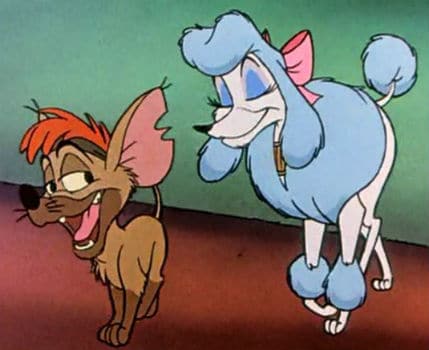
Photo: Disney
Thirdly, sometimes family isn’t what you expect. Oliver didn’t think he would find a family with Dodger and the gang, with Jenny and Georgette, or even with all of them at the end. But he manages to find a close knit community and make his own family. Some of us are blessed with being born into amazing families and just add to them while others have to start from scratch. Either way, there is no set “family formula.”
Fourthly, don’t underestimate what people will do for their loved ones. I think this one speaks for itself.
Fifthly, take care of your pets. Being a stray is scary, especially when you’re a tiny cat who almost gets washed down a drain. Don’t just leave them in cardboard boxes because “someone might pick them up,” take them to a shelter. Spay and neuter to prevent access strays. Your abandoned pet may end up adopted by a little girl who lives on Park Avenue with her pure-bred poodle, or be taken in by a lovable gang of dog pickpockets, but it also might get eaten by Doberman Pinschers or washed down a drain. It seems like it could really go either way. So, be a responsible pet owner.
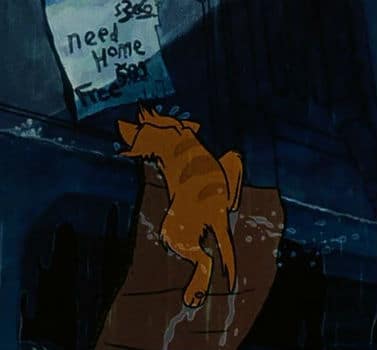
Photo: Disney
Finally, don’t deal with loan sharks. It’s never a good idea.
DOES IT HOLD UP?
Honestly, I wasn’t sure about this Oliver & Company. I was looking at it a bit more skeptically than other treasured nostalgic favorites because it was never as beloved to me as The Great Mouse Detective or some of the other films to come out of the ’80s and early ’90s, but I have to admit, this is still a really fun movie. The animation looks great, the music is still catchy and wonderful, and the story is solid. I like the bit of gray that is in most of our characters, and there are worse movies. Plus, it’s always once upon a time, and why should I worry? See what I did there? But seriously. It’s fun, upbeat, pretty, and, honestly, hilarious. At only 74 minutes, it’s well worth a watch.
For next week: The Little Mermaid
If you enjoyed this post and the others in the Revisiting Disney series, and have found yourself wishing that you could find them all in one convenient and bound book with eight extra essays, there is an option for you! Check out A Journey Through Disney: My Look Back Through Disney Canon, now available on Amazon as both a Kindle book ($4.99) and a paperback ($11.99).
OTHER SOURCES:
https://thewaltdisneycompany.com/about-disney/disney-history
http://www.imdb.com
http://studioservices.go.com/disneystudios/history.html
http://www.history.com/topics/1980s
Bailey, Adrian. Walt Disney’s World of Fantasy. Everest House Publishers. New York, New York. 1982.
Finch, Christopher. The Art of Walt Disney: From Mickey Mouse to the Magic Kingdom. Harry N. Abrams, Inc. New York, New York. 1975.
Johnston, Ollie and Frank Thomas. The Disney Villain. Hyperion. New York, New York. 1993.
Sale, Roger. Fairy Tales and After: From Snow White to E.B. White. Harvard University Press. Cambridge, MA, 1978.
Tatar, Maria. The Annotated Classic Fairy Tales. W.W. Norton and Company. New York and London, 2002.
Thomas, Bob. Disney’s Art of Animation From Mickey Mouse to Hercules. Hyperion. New York, New York. 1992.
Wright, Gordon. The Ordeal of Total War: 1939-1945. Harper Torchbooks, Harper & Row. New York, Hagerstown, San Francisco, and London, 1968.
ARE YOU A ROMANCE FAN? FOLLOW THE SILVER PETTICOAT REVIEW:
 Our romance-themed entertainment site is on a mission to help you find the best period dramas, romance movies, TV shows, and books. Other topics include Jane Austen, Classic Hollywood, TV Couples, Fairy Tales, Romantic Living, Romanticism, and more. We’re damsels not in distress fighting for the all-new optimistic Romantic Revolution. Join us and subscribe. For more information, see our About, Old-Fashioned Romance 101, Modern Romanticism 101, and Romantic Living 101.
Our romance-themed entertainment site is on a mission to help you find the best period dramas, romance movies, TV shows, and books. Other topics include Jane Austen, Classic Hollywood, TV Couples, Fairy Tales, Romantic Living, Romanticism, and more. We’re damsels not in distress fighting for the all-new optimistic Romantic Revolution. Join us and subscribe. For more information, see our About, Old-Fashioned Romance 101, Modern Romanticism 101, and Romantic Living 101.

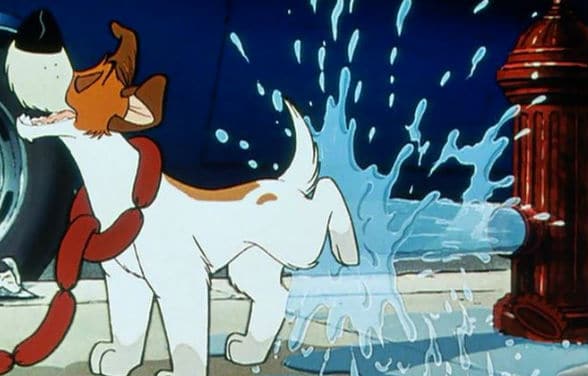

Comments are closed.